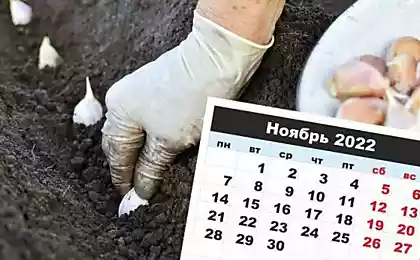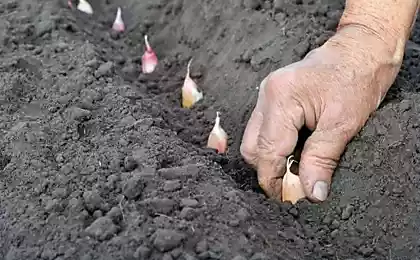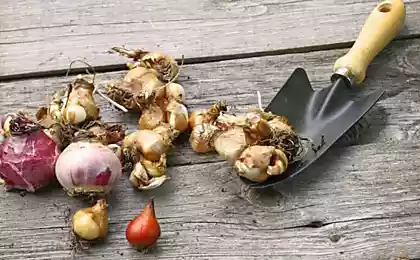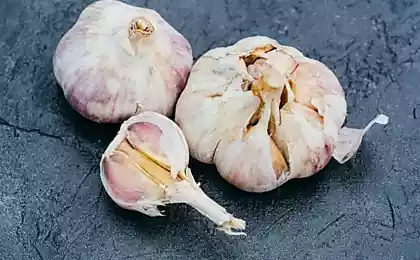248
When to plant winter garlic - the experience of growing garlic

Winter garlic: when to plant and when to collect? For many years we have been growing garlic in the country. Why? Because the store sells something that is difficult to call garlic. I do not know whether the variety is determined by such strange taste and olfactory qualities, or by special processing. The result is one – we grow garlic ourselves, despite all our laziness. Especially since garlic does not require much effort.
Winter or spring? Garlic can be planted either in autumn, in winter, or in spring. Winter garlic and spring garlic differ not only in planting time, but also in variety. Winter garlic "accelerates" by the end of July - early August. Spring later, but better winter carries storage.
Today we will talk about planting, care and harvesting of winter garlic.

We have been growing garlic in the country for many years and planting it in the autumn. For planting winter garlic, heads with the maximum number of teeth are selected. The largest external teeth are selected from the selected heads.
Remark: If you choose heads with a small number of large lobes, a significant part of the harvest will be spent on planting, which, you will agree, is offensive.
If you do not yet have your own garlic harvest, contact the garden centers. Let me remind you again: winter and spring garlic are different varieties.
The general rule of planting winter garlic is the same as for other bulbous: on the one hand, garlic should
have time to take root before the soil freezes, on the other hand, do not start growing the above-ground part. Garlic takes about 40 days to root. In the Moscow region, the average time of autumn planting of garlic from 1 to 10 October. Of course, it is not necessary for a year to guess the weather.
Preparation of the soil under garlic In particular demanding to the soils, garlic was not noticed. In the prepared bed it would be good to add humus, superphosphate and potassium sulfate. When planting garlic in autumn, you should not feed it with nitrogen fertilizers (nitrogen stimulates the growth of greenery, but we do not need this in autumn at all).
The garlic planting scheme is planted in rows. Between the rows, the distance is 20 cm, between neighboring plants in a row - 10 cm. In a small peg, we make a depression under each clove: in light soils 7-8 cm deep, in heavy soils 6-7 cm. The depth of the hole will be the distance from the bottom of the clove to the surface of the soil. We put cloves in the holes and sprinkle the earth. Okay.
It is advisable for the winter to cover the garlic beds with a top: cut flowers, leaves, etc. for effective snow retention.
In the spring after the melting of snow carefully and shallowly loosen the garlic bed. To stimulate growth, it is good to feed garlic with nitrogen fertilizer - 1 tbsp. spoon of urea per bucket of water. Many plants respond gratefully to such spring feeding - thuya and apple trees, for example.
In summer, garlic is weeded, soil moisture is monitored - garlic does not like drought. When arrows appear (about 10 cm), they should be broken, otherwise the harvest will decrease.
Sign of readiness of winter garlic for harvest: about half of the leaves have turned yellow. Usually in the suburbs this happens in late July - early August. Seriously late with the harvest should not be, since overripe heads can crumble into separate lobules.
Garlic is carefully dug out with pitchforks, leaving both the top and the roots. Excavated plants are dried on a tray, then weave into braids.
So the harvest is harvested, and that's where the most lazy part of garlic care begins. Because the bulbs need to be properly dried. Drying, or rather, roasting garlic in the sun allows you to save it, as well as prepare for the next planting. Quality drying replaces the chemical treatment of planting material.
Garlic braids should be dried in the sun. In our climate, this is not easy. In August, it starts (or continues) rains, you have to constantly ensure that the harvest is not wet. A sign of the readiness of garlic is the complete drying of the stems and bulbs. In our conditions, it takes, alas, about a month.
After drying, you can cut the roots and stems, but leaving a foam of 3-5 cm.
You can store the garlic crop in cardboard boxes in a non-hot room, for example, near the slit of the balcony door. If the area and style allows, you can simply hang garlic braids on the walls.
Source: sadovos.ru/






















